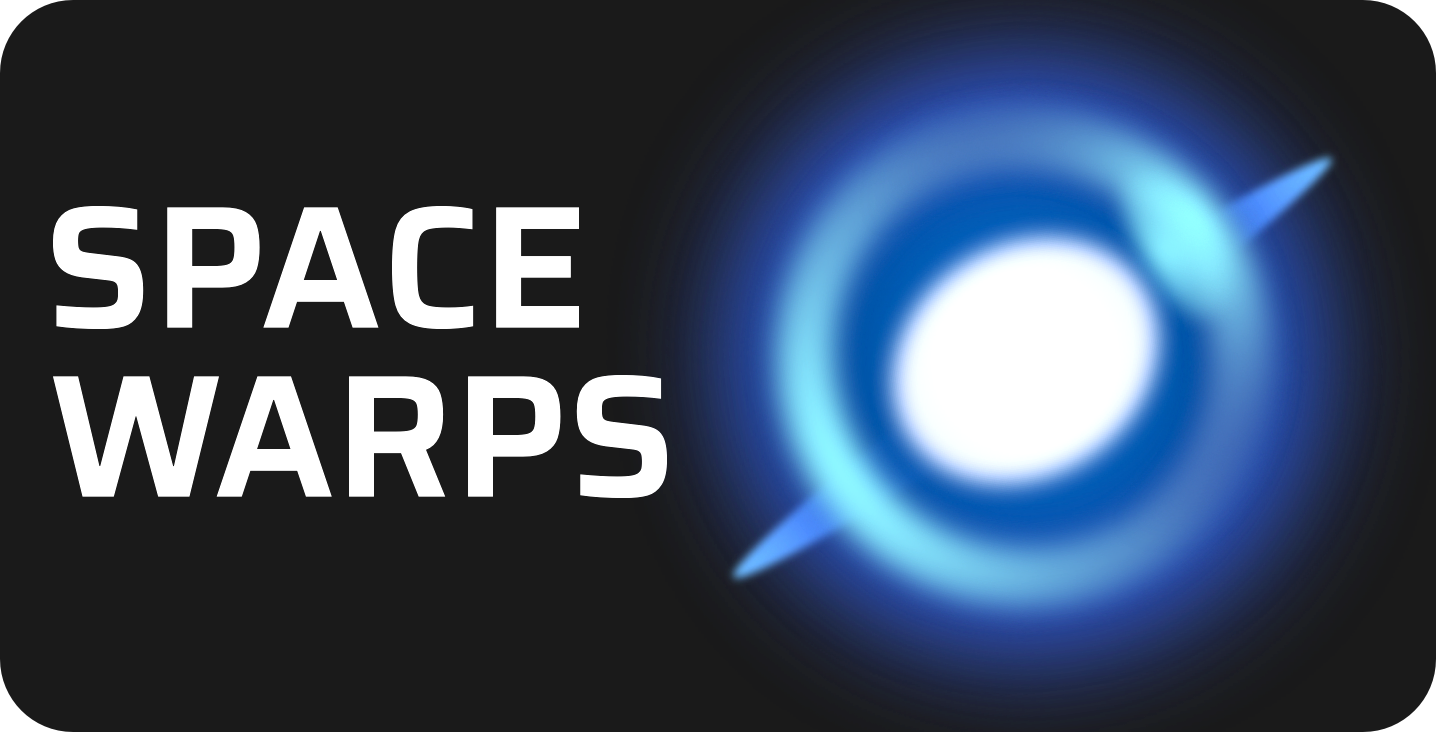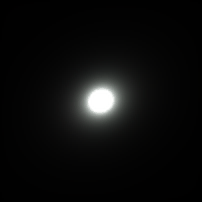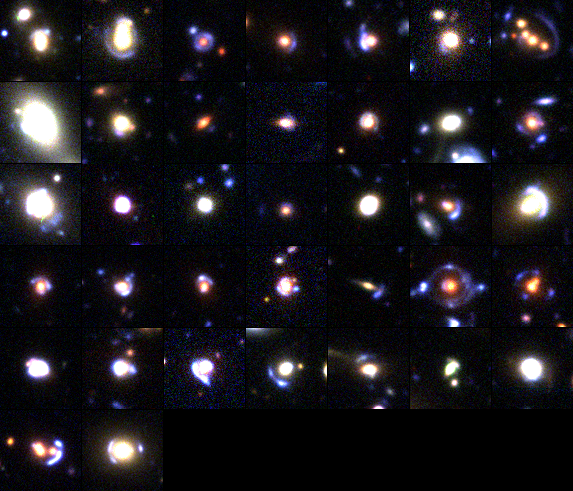Help Us Weigh Galaxies!
10:12 minutes
 This is part of our collaboration with Zooniverse and the Space Warps research team to identify brand new gravitational lenses. Want to hunt for gravitational lenses and contribute to scientific discovery? Go to spacewarps.org to help astronomers identify these special gravitational mirages! If you want to know the results, listen to our follow-up segment.
This is part of our collaboration with Zooniverse and the Space Warps research team to identify brand new gravitational lenses. Want to hunt for gravitational lenses and contribute to scientific discovery? Go to spacewarps.org to help astronomers identify these special gravitational mirages! If you want to know the results, listen to our follow-up segment.

Science Friday is partnering with citizen science platform Zooniverse to help a team of astrophysicists identify galaxies showing an astronomical phenomenon known as gravitational lensing.
Gravitational lensing occurs when the light coming from a galaxy, quasar, or other bright object is bent and distorted by a massive object in front of it, giving the light the appearance of passing through a “lens,” like how an image appears through a magnifying glass. These lenses are rare, but incredibly neat.
The light distortion caused by a massive object provides a zoomed-in view of the galaxy or quasar behind it. The amount that the massive object in the foreground bends the light of the object behind it can provide a measure of its mass. Gravitational displacement—how much space and time is bent by gravity—is proportional to an object’s mass, according to Einstein’s theory of general relativity. The bigger the lens, the more massive the object that is doing the lensing.

So, a gravitational lens essentially allows us to weigh a galaxy. Pretty cool, right? But, we need your help to find more lenses! With the aid of the citizen science website Zooniverse, everyone can take part in this real, cutting-edge area of research. You can help contribute to making a real discovery!
[Join the hunt for gravitational lenses!]
Why is this a citizen science project? Well, humans are much better at identifying gravitational lenses than computers are. With extremely minimal training, we’re more accurate and can process more images than a computer can. Plus, anyone can participate in learning more about space and advance exciting scientific research in a tangible way. So, share this with as many friends as you can!
The hunt is starting this Friday, April 27th. On the following Friday, May 4th, Science Friday will do a wrap-up with Space Warps’ principal investigators on-air, who will reveal some of the discoveries team SciFri found!
Update: want to know the results of that week? Listen to our follow-up segment!
Laura Trouille is Director of Citizen Science and Co-Investigator for Zooniverse. She’s based at the Adler Planetarium in Chicago, Illinois.
Aprajita Verma is co-founder of Spacewarps, and a senior researcher in astrophysics at the University of Oxford in Oxford, England.
IRA FLATOW: Of all the predictions of Einstein’s general theory of relativity was that gravity of massive objects, like the Sun, would warp and deform space-time and therefore deflect passing sunlight, wrenching into– turning it into sort of a curved path. Well, that prediction was famously verified during a solar eclipse in 1919, when a photograph of the eclipsed disk of the Sun revealed that a certain star seemed slightly out of place due to the gravitational warp of the Sun– fit right into what Einstein had predicted.
And then that same phenomenon can also reveal one galaxy behind another through something called gravitational lensing. It helps us see what we might otherwise not see, invisible behind one star.
And sometimes, you citizen scientists, this is something you can help professionals detect. We’ve teamed up with the citizen science group Zooniverse to launch a new challenge for amateur astronomers. It’s called Space Warps. And joining me to talk about it are Laura Trouille, vice president of Citizen Science at the Adler Planetarium in Chicago and co-leader of Zooniverse. Welcome to Science Friday.
LAURA TROUILLE: So glad to be here. Thank you.
IRA FLATOW: You’re welcome. And Aprajita Verma is a senior researcher in astrophysics at the University of Oxford in England and co-founder of Space Warps. Welcome to Science Friday.
APRAJITA VERMA: Thank you very much.
IRA FLATOW: So, Aprajita, tell us more about gravitational lensing. How can we see a galaxy hiding behind another galaxy?
APRAJITA VERMA: It sounds crazy, right? You wouldn’t think that you’d be able to see such things. But it’s literally one of the most direct predictions of general relativity, as you mentioned earlier, that space-time gets warped or light gets bent under the influence of a massive galaxy. And lined behind it, if you’re lucky with alignment, you can have a distant galaxy that basically gets magnified and amplified. So the galaxy in front is acting much like a magnifying glass you would have to look at letters in more detail. You can see galaxies in more detail in the same way.
IRA FLATOW: All right, so let’s talk, Laura, about Space Warps. Tell us what people are going to be looking for in this Space Warps project.
LAURA TROUILLE: So we’re inviting your listeners to join us in a 1 million classification challenge. And what they’ll be doing is looking at images of, as Aprajita mentioned, these potentially lens galaxies. And they’ll just mark whether they see a lens or not. And the hope, the expectation is that by next Friday, we’ll be able to come back to your show and say, hey, from these 1 million classifications, your community was able to find maybe a half dozen new gravitationally lens galaxies. And that will be a huge boost to this area in research.
IRA FLATOW: So it’s possible for nonscientific people, for citizen scientists to actually look at the photos and say, hey, there’s lens warping, there’s not lens warping?
LAURA TROUILLE: Yeah. So on all zooniverse.org projects and spacewarps.org, you can, if you’re a five-year-old to a 95-year-old. It’s just about this really wonderful capacity for our human eyes to recognize patterns. So it’s just looking at the images, and looking at the guiding images, and seeing whether you see one of these lens characteristics.
IRA FLATOW: Aprajita, how many of these gravitational lens galaxies do we know about already? And how many more do you think you might find in this project?
APRAJITA VERMA: Well, we kind of know, let’s say, we’ve confirmed about 500 to 700 of them. But there’s probably another factor of two to three kind of candidates. And we should expect in this search to find another– when we’ve completed the whole thing, at least another hundred or so. So you can see that’s quite a significant step change.
And they’re really rare events. So only one in a million galaxies will act as a lens. And so finding these rare sources is really like finding a needle in a haystack, but doing it with citizen power.
And as Laura mentioned, this human ability to recognize patterns and to adapt and be creative are all kind of things that machines or algorithms find really hard. So this is really where citizen scientists can contribute and help with our research in a really constructive and hopefully fun way.
IRA FLATOW: I think it’s a great idea. But I’m wondering in this age where we have facial recognition and artificial intelligence, Laura, why do we still need people? Why can’t we train your cell phone to look at a picture and say, hey, it’s a warp?
LAURA TROUILLE: So part of it is that the human pattern recognition are creating training sets for machine-automated routines to do this type of work. But as Aprajita mentioned, for projects like this where the shapes are quite unusual and tricky to discern, human eyes are really best at doing this. And then they train the automated machines to do this from that information.
IRA FLATOW: And how many people do you want for this project?
LAURA TROUILLE: So if every one of your listeners went on tonight or right now and just did one classification, we could reach our 1 million classification goal. But the idea is that for all Zooniverse projects, we have thousands to tens of thousands of people who participate, who contribute through classifications and then in the discussion forums. And we have 1.6 million people around the world who are part of Zooniverse. And so it’s a neat opportunity for your listeners to join this very science-oriented community online.
IRA FLATOW: I’m Ira Flatow. This is Science Friday from WNYC Studios. In case you just joined us, we’re talking about a Space Warps project, a citizen science project, with Laura Trouille Aprajita Verma.
Aprajita, I mentioned dark matter before. What role does dark matter play in this?
APRAJITA VERMA: Well, you can think of dark matter like the fabric of our universe. So we think that galaxies formed in clusters of galaxies in these concentrations of dark matter. Now, that sounds really great, but it’s really hard to find. So we can think of the light we see from galaxies as kind of pinpointing these areas of dark matter concentration, but we can’t actually see the dark matter, obviously, because it’s dark.
But gravitational lensing gives us an extra handle in that the way it works is that it’s sensitive to the total matter. So that’s the dark plus the light matter. So it’s actually one of the most direct ways of measuring the dark matter content around galaxies. And that’s not just how much there is, but also how it’s distributed. And that’s what dictates these kind of lensed images and patterns that we see. So you can see it’s a really direct means of measuring this elusive substance that pervades the universe.
IRA FLATOW: So if you see the amount of lensing that takes place and you know the amount of visible matter there, if you subtract the visible, you are left with how much dark matter is there? Is that oversimplification?
APRAJITA VERMA: Basically. No, no, no, that’s exactly right. So basically, we use this assumption that light traces the matter, but that’s the visible matter. And the lensed images trace the total matter. So what you just said is perfectly right.
IRA FLATOW: Boy, it’s nice to be perfectly right every once in a while. OK, so let’s say I’m excited about this. I want to get involved in this. Now, will people who classify these images end up as co-authors, let’s say, if you discover something, on the papers or anything like that?
APRAJITA VERMA: Yeah, in our previous runs, we’ve had the citizens, some citizens who’ve participated very strongly as co-authors. But more importantly, what we see is this kind of classification exercise is a community effort. So absolutely everyone who places any kind of classification on the system, their Zooniverse ID will be part of our website and shown in our papers. So every classification counts and every person that makes them count.
IRA FLATOW: Yeah, because we have a tweet coming in from Ashley Miller that says, thank you for the citizen science project. My 10-year-old did her science fair project on gravitational lensing. And she will be so excited to participate this weekend. So tell us how to participate.
LAURA TROUILLE: So–
IRA FLATOW: Go ahead.
LAURA TROUILLE: –definitely head to spacewarps.org online or on your phone. You can also download the Zooniverse mobile app on Android or iPhone, and go participate there. And it’s really just as simple as just opening up that URL and clicking on Start Classifying. And right away you’re contributing to science. You’re helping these researchers unlock their data.
IRA FLATOW: And so we will be coming back next week to follow up to see how well we did?
APRAJITA VERMA: Yep.
LAURA TROUILLE: Yes, definitely. We’re looking forward to that.
APRAJITA VERMA: Yep. Absolutely.
IRA FLATOW: People are going to be fearful again. They’re going to say, hey, I’m not good enough to do this. But you’re saying anybody can participate–
APRAJITA VERMA: Yeah.
IRA FLATOW: –in this.
APRAJITA VERMA: Anybody’s good enough. And every classification counts. And even people who are habitually wrong contribute as much power in the way we’ve set up the analysis to people who are always right. So everything, everything counts.
LAURA TROUILLE: Right. And importantly, for every image, multiple eyes, many people classify the same image. So even if you’re a little unsure, know that there’s between five to 25 other people who will classify that same image. And then the researchers use that whole spread of classifications to have confidence in the final classification result.
IRA FLATOW: That’s great. That’s great. OK, we’re going to send everybody there. I want to thank both of you for taking time to be with us today. Laura Trouille, vice president of citizen science at the Adler Planetarium– great planetarium– in Chicago, co-leader of Zooniverse, and Aprajita Verma, who is a senior researcher in astrophysics at the University of Oxford in England, co-founder of Space Warps. Thanks again for joining us today.
LAURA TROUILLE: Thanks so much.
APRAJITA VERMA: Thanks.
IRA FLATOW: You’re welcome. I want to give out that URL. If you want to get involved, do some of this astronomy work yourself, go to sciencefriday.com/spacewarps, sciencefriday.com/spacewarps.
Copyright © 2018 Science Friday Initiative. All rights reserved. Science Friday transcripts are produced on a tight deadline by 3Play Media. Fidelity to the original aired/published audio or video file might vary, and text might be updated or amended in the future. For the authoritative record of Science Friday’s programming, please visit the original aired/published recording. For terms of use and more information, visit our policies pages at http://www.sciencefriday.com/about/policies/
Christopher Intagliata was Science Friday’s senior producer. He once served as a prop in an optical illusion and speaks passable Ira Flatowese.
Dee Peterschmidt is a producer, host of the podcast Universe of Art, and composes music for Science Friday’s podcasts. Their D&D character is a clumsy bard named Chip Chap Chopman.
Ariel Zych is Science Friday’s director of audience. She is a former teacher and scientist who spends her free time making food, watching arthropods, and being outside.